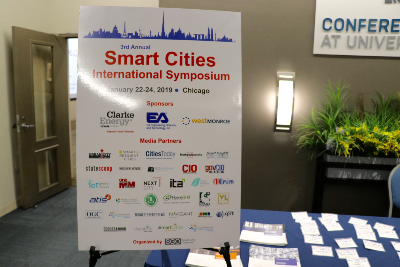By Xieyang Jessica Qiao
Medill Reports
As vehicle automation and electrification gain traction, they create a new mobility ecosystem for Chicago to tap into. Yet the city’s traditional residential infrastructure and limited connectivity could hinder Chicago and other metropolises in their ability to innovate.
Waymo, Google’s autonomous car subsidiary, announced last year they would purchase over 60,000 vehicles from Fiat Chrysler and 20,000 electric vehicles from Jaguar for the self-driving car fleet.
“According to Morgan Stanley’s estimate, the potential market cap of Waymo is $175 billion if they launch an initial public offering,” said Gary A. Silberg, the Americas head of automotive innovation at the audit firm KPMG.
Silberg spoke during the 3rd Annual Smart Cities International Symposium & Exhibition in Chicago. “The number of miles we travel is actually going to soar. This changes the entire economy of the transportation sector,” he said.

Autonomous and electric vehicles now represent a magnitude of growth never seen before and the city of Chicago is positioning itself as a prime electric vehicle marketplace. In addition to an expedited permit process for station installations and over 50 fast chargers, Chicago also has a proficient electric vehicle installation network.
“Back when electric vehicles came into the market, the State of Illinois took an aggressive role to ensure that people who are installing electric vehicle charging stations are properly trained and certified,” said Samantha Bingham, clean transportation program director of Chicago Department of Transportation.
While Chicago adapts to technological changes that are revolutionizing the transportation system, barriers such as home infrastructure still hinder the adoption of electric vehicles.
“Most electric vehicles are registered at single family homes, yet most Chicagoans live in multi-unit buildings,” Bingham said. “It’s also a challenge to encourage electrification of personal vehicles due to the lack of easy and affordable charging at home.”
While this limitation holds back the city’s market of private electric vehicles, Chicago could move beyond it by focusing on providing networked charging stations for fleet vehicles.
“Transportation fleets can significantly impact the electric grid. If lacks on management, electric fleet could place a huge burden on grid,” said Elizabeth A. Kocs, director of energy initiative at the University of Illinois at Chicago. “If fleet charging is managed properly, however, they could provide an even bigger benefit to the grid than a passenger electric vehicle could.”
This idea of connectivity spurs “a whole urban electricity generation picture” that requires an integrated mobility ecosystem, said Dr. Peter Harrop, chairman of IDTechEx, a British market research company.
“Increasingly, underground, surface and air vehicles in smart cities will be connected, electric and driverless,” Harrop said. “We need to reinvent photovoltaics on almost everything. All vehicles could be zero emission and some will be carbon reducing or generating more electricity than they need.”
Essentially, in order to optimize smart mobility that leverages electrification and automation, Chicago needs to operate things from a network perspective and eliminate silos, whether they are within an agency, between agencies, within companies or between industries.
“While the amount of data is increasing at a phenomenal rate, it’s still often locked up on these different silos,” said Monali Shah, head of industry solutions at Google. “As we look at the ways to operate transportation networks, it’s really breaking down these silos and bringing together different data elements that can help us make more integrated decisions.”
She referred to data silos created by different transportation agencies, for instance.
In Chicago, however, the divided transit system governance slows progress toward creating a seamlessly integrated mobility ecosystem.
“Right now, it’s really challenging because you have separate agencies and different levels of government,” Shah said. “Along with that comes the way we make choices as consumers and travelers. Now, it’s a big opportunity for us to shift that thinking.”
Shah maps out a three-dimensional approach toward synchronization. In addition to moving from the slow and bureaucratic process to a nimble and adaptive environment, Chicago needs to implement scalable solutions and build a digital infrastructure network.
“Being able to shift our thinking from a project-based approach to more broader scale solutions that can be implemented across agencies is an important concept,” Shah said. “We also need a digital mechanism that is able to interpret data, communicate and put out information to individual entities.”
Silberg said there is no federal government solution for how to make Chicago a smart city with eco-mobility and connectivity,.
“If we figure out this in Chicago, we will lead the world. If we don’t, the high tech players are going to come to our city” to lead markets they will dominate, Silberg said.

